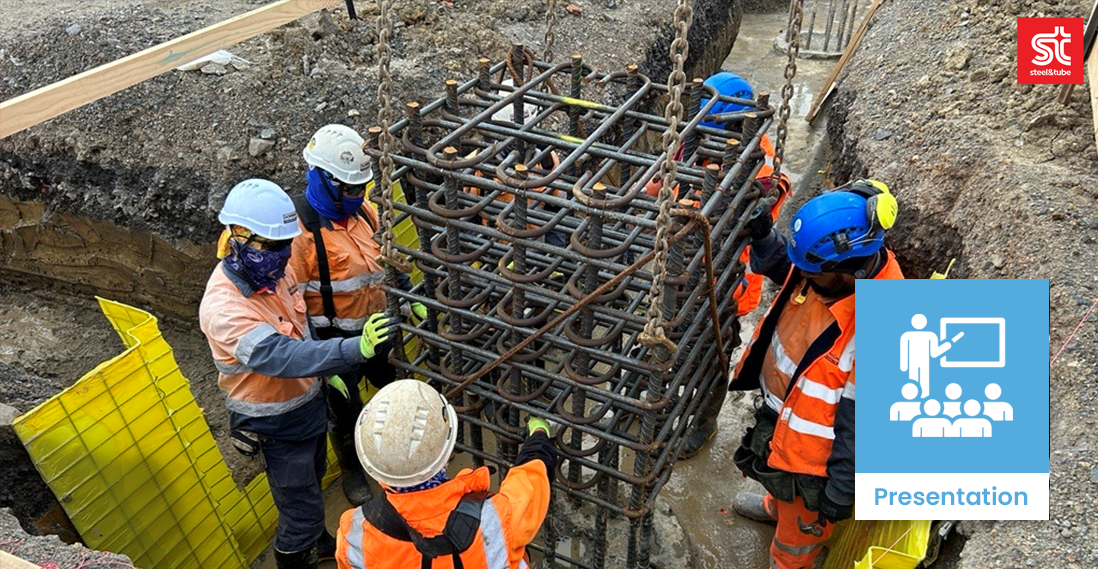Steel and Tube: A new resource for health and safety
Summary
Steel & Tube, a reinforcing steel fabricator in New Zealand, has successfully adopted BIM technology to streamline their processes, enhance product delivery, and improve health and safety outcomes. Using 3D modelling software like Tekla Structures, they can create detailed visualisations of complex structures, plan sections of work for prefabrication, and share models with clients and on-site teams. This approach has resulted in substantial reductions in errors, increased efficiency, and the creation of safer working environments for project stakeholders.
Background
Steel & Tube is a well-known company in New Zealand, recognised for selling steel and related products. As part of their business, they fabricate and supply reinforcing steel for various construction projects, such as bridges, buildings, and foundations.
Traditionally, the process of fabricating reinforcing steel relied heavily on manual interpretation of engineers’ drawings, detailed shop drawings, and error-prone manual processes. This often resulted in waste, rework, and the need for on-site adjustments, which could lead to potential health and safety risks for workers.
Video
Approach
Recognising the need for change, Steel & Tube invested in Tekla Structures, a 3D BIM modelling software, in 2021. The goal was to enhance their internal processes and add value to their reinforcing steel products. Specific examples of improvements made using BIM include:
1. Imagining and building the structure before going to site: For the ACC Office Building project in Dunedin, Steel & Tube built a reinforcing model that considered the future steel structure, trusses, and substructure. They also performed clash checks with holding down bolts and service penetrations through the foundation. This level of detailed planning helped reduce rework and errors on site.
2. Tackling complex geometries and prefabrication: On a wind farm project, Steel & Tube used 3D modelling to manage the fabrication and installation of reinforcing steel for 40 planes in a harsh environment with complex shapes. For the new IKEA building in Auckland, they are delivering 60-70% of the structure as prefabricated elements. BIM enables them to plan and execute prefabrication in a controlled workshop environment, reducing on-site risks and improving quality.
Health and safety benefits
Health and safety considerations didn’t feature in Steel & Tube’s initial decision to invest in 3D modelling software and capability, but their increased use of modelling has highlighted a range of health and safety benefits that have come with it:
- Reduced errors and rework: By using 3D models to plan and visualise structures before construction, Steel & Tube can ensure a better fit and reduce the need for on-site adjustments. This minimises the potential for errors and rework, which can often lead to health and safety hazards on construction sites.
- Increased prefabrication opportunities: BIM enables Steel & Tube to easily identify opportunities for prefabrication, allowing them to fabricate reinforcing steel in a safer, more controlled environment. By reducing the amount of work done in situ, they can minimize the exposure of workers to potential hazards, such as working on uneven surfaces or in confined spaces, and can provide a more ergonomic working environment.
- Improved accessibility to models: By providing clients with easy access to 3D models through QR codes and web-based platforms, Steel & Tube ensures that everyone on site can view and understand the reinforcing steel layout at any given time. This improved accessibility promotes better communication and coordination among project stakeholders, ultimately leading to a safer work environment.
Lessons learnt
BIM can help transform trades (for the better!)
Reinforcing steel is considered a “rough and dirty trade” and not an exact science. By adopting BIM technology, Steel & Tube has been able to transform this traditional trade through increased prefabrication, both in the factory and on-site. This helps bring more precision and efficiency to the process, as well as making it safer and less strenuous for workers.
Easy access to models benefits everyone
Providing simple, accessible ways for clients and site teams to view and interact with 3D models ensures that everyone has the information they need to make good decisions, anticipate challenges, and ensure that work is carried out safely and efficiently.

